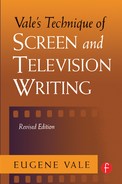7
By investigating the physical characteristics of the motion picture form, we arrived at the conceptions of space, picture and sound, means of expression, enlargement and composition, the scene with its components of place, time and the lapse of time, the selection of information, and the division of knowledge. The enumeration of these factors is sufficient to prove that the motion picture is a new and original form of storytelling, as different from the others as the opera from the short story, or the stage play from the novel. Hence we must cease to consider this new form as a slight variation from existing methods of storytelling. Instead of burdening it with rules and prejudices from other arts, we must concede to it an independent life and shape. To stress this point even further, it may be advantageous to compare the physical characteristics of the three principal forms of storytelling.
At times, their similarities are overestimated; then again, their differences are exaggerated. There are comparatively few writers who are equally familiar with each of these media. The preference of a writer for a particular form does not necessarily result from his greater experience in handling one or the other medium. It is also determined by his temperament, which may prefer a specific form.
The chart on the following page facilitates a clear evaluation of the differences between the three forms. Though this chart takes into consideration only the physical characteristics, it must be kept in mind that their differences determine the more vital differences between the dramatic structures of the novel, the stage play, and the motion picture.
If we balance the findings of this chart, it becomes clear that the form of the novel is rather shapeless, allowing the author much liberty, whereas the stage play is very restricted, subjecting the playwright to a rigid structure. As for the motion picture, the chart seems to indicate that it is a child of the novel and of the stage play, incorporating some of the characteristics of both and, in some instances, creating new ones.
From the novel it has the freedom of time and place. From the theatre it has the definite length of performance, the representation of events, the lack of expressing the thoughts of the characters as well as of the author, the lack of descriptive, explanatory and connecting sentences. As in the theatre, its audience must understand the story in one sitting.
Among the new characteristics, we recognize the sources of information of the motion picture which differ from the novel and the stage; the greater amount of scenes, as compared to the theatre, but restricted with regard to the novel; the problem of the selection of information; the decisions with regard to enlargement; the use of the lapse of time.
Chart of Comparison

† Long ago, a country-bumpkin sat through numerous screenings of a silent movie showing a woman undressing in back of a railroad track Finally, the usher nudged him “Sir, you’ve seen this film at least eight times. What are you waiting for?” The bumpkin held his breath, then gasped “For the (expletive deleted) train to be LATE!”
As for the Chart of Comparison, its purpose is to offer guidelines, in the full realization that there are exceptions to every rule. For example: the matter of picture length — Erich von Stroheim’s 1925 silent film classic Greed ran eight hours in the director’s original cut and Kenneth Branagh’s 1996 rendering of Hamlet was put into general release at a full four hours.
Regardless of partial similarities, the motion picture is a new form, independent of the novel or the theatre. Not giving a definition, but merely an illustration, we could say: the motion picture is theatre carried to every location that might be chosen by the novelist. This expresses the fact that the motion picture must be dramatically conceived and may yet be epic. To find the right measure is the great difficulty of screenplay writing.
The author who begins to write for motion pictures should not believe that he approaches a perfect form of art. His illusions about the great freedom of motion pictures are soon destroyed. He must realize that he has to deal with an invention which was born with great advantages together with great deficiencies. He will be tom between both extremes. He will find himself in a constant dilemma between his wishes and his resignations. These possibilities and limitations hold and confine each other. They battle with each other in every scene.
The motion picture offers many possibilities, which, because they exist, demand to be exploited. But the peculiar form of this new art contains many obstacles which obstruct the successful fulfillment of all its possibilities. Although it has many means of expression, it lacks some of the most essential ones. Although it has freedom of place and time, it has difficulties of exposing place and time. Although it has the possibility of introducing many characters, it lacks the essential means of characterization: description of thoughts. Although it can show many events, it has difficulty elucidating them because it is not aided by descriptive or explanatory sentences. Although it has the possibility of selecting scenes, it has difficulty connecting these scenes. Although it can tell an extensive, varied story, it is limited by space.
All the more reason for the writer to study the nature of the motion picture carefully so as to learn how to overcome its limitations. As for television, its burgeoning essence will be corralled in a later chapter.
